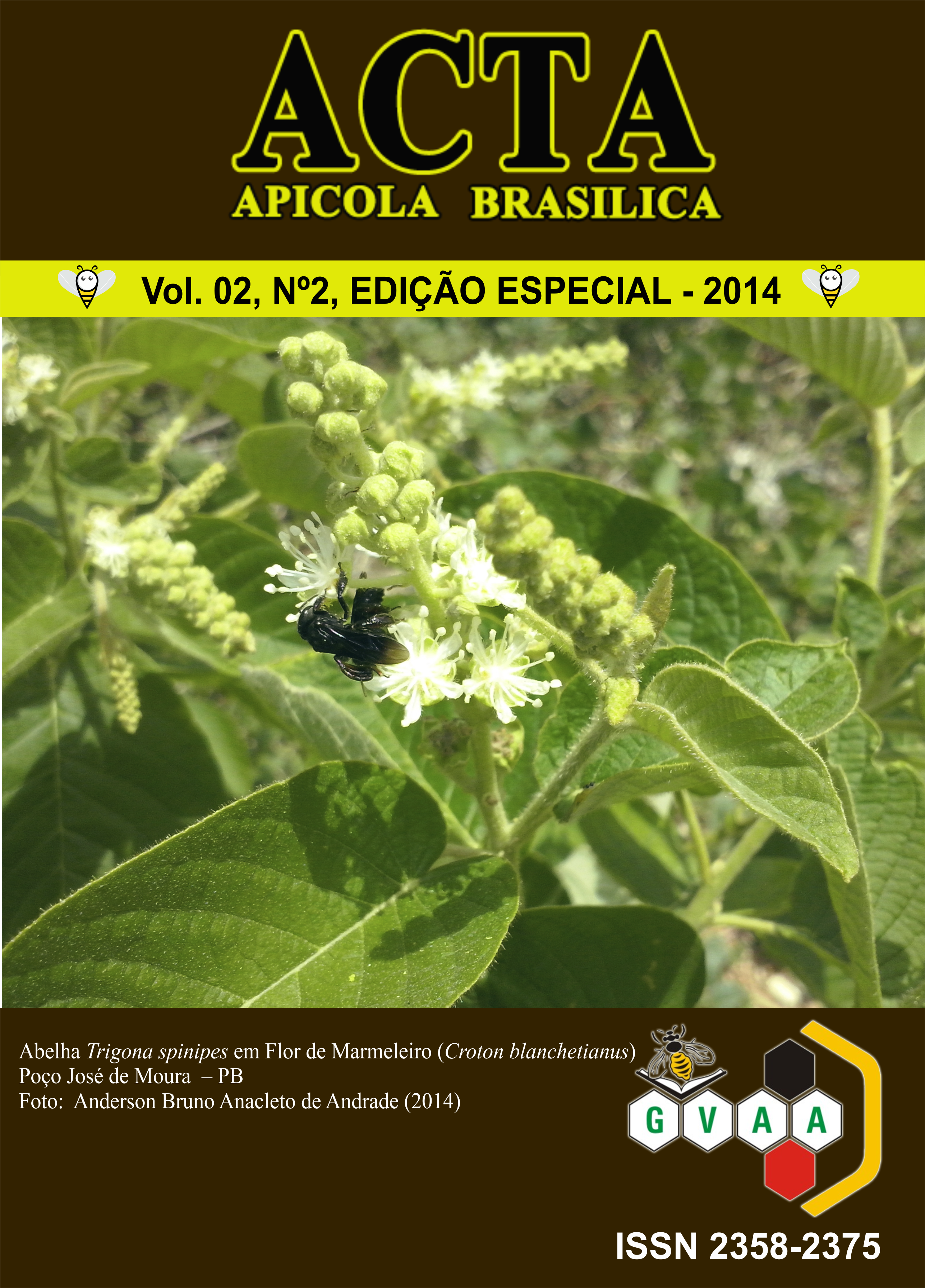Apitoxin and its Anti-inflammatory activity and anti-nociceptive
DOI:
https://doi.org/10.18378/aab.v2i2.3737Keywords:
Poison, Membrane, PharmaceuticalsAbstract
The bee venom is the poison used by bees of the genus Apis for their protection and defense against numerous natural enemies. Its composition is complex and consists of a mixture of enzymes (Fosfalipase A2 and Hialorunidase) peptides (Melittin, Apamin, and Peptide MCD), amines (histamine, dopamine, and noradrenaline) carbohydrates and lipids once inoculated apitoxin to trigger a series of biological reactions on the membrane, which vary according to the biochemical diversity of its constituents. In the present scenario, the bee venom production is a different activity within the beekeeping, with great potential for the pharmaceutical market, the ability to produce numerous drugs. In this paper, we focus on the production and collection of bee venom by addressing its chemical composition, its pharmacological properties and therapeutic activities, focused on its anti-inflammatory action and anti-nociceptive.
Downloads
References
ALVES, E. M. Composição farmacêutica contendo fração de apitoxina e uso. Patents WO2011041865 A1, 2011.
BRASIL. Instrução Normativa n.3, de 19 de janeiro de 2001. Regulamento técnico para fixação de identidade de apitoxina. Disponível em:
<http://www.agricultura.gov.br.>. Acesso em 12 julho.2014.
BRUNTON, L. L.; LAZO, J. S.; PARKER, K. L. Goodman & Gilman. As bases farmacológicas da terapêutica. 11. ed. Rio de Janeiro: McGraw-Hill Interamericana do Brasil, 2007.
BROADMAN, J. Bee Venom - The Natural Curative for Arthritis and Rheumatism. New York, Putnam & Sons. 1962. 224 p.
DANTAS, C. G.. et al. Apitoxina: coleta,composição química, propriedades biológicas eatividades terapêuticas. Revista Ibero‐Americana de Ciências Ambientais, Aquidabã, v.4, n.2, p.127‐150,2013.
DIAZ, J.C.; RIVERA, T.G.; PIÑEIRO, A.D.;MALFATTO, M.P.;PINILLA, H.S.M. Apiterapia Hoy en Argentina, Cuba Uruguay y Colombia. Quinta edicion. 2010. 53p.
DOMERENGO, Pr. R.. La thérapie au venin d’abeille. Baroch Editions, 2012, p. 113
DOTIMAS, E. M.; HIDER, R. C.. Honeybee venom. Bee world, v.2, p.51-71, 1987.
FITZGERALD, G. A.; PATRONO, C.. The coxibs, selective inhibitors of cyclooxigenase-2. The New England Journal of Medicine, v.345, n.6, p.433-442, 2001.
FERREIRA Jr., R. S.; SCIANI, J. M.; MARQUES-PORTO, R.; JUNIOR, A. L.; ORSI, R. de O.; BARRAVIERA, B.; PIMENTA, D. C.. Africanized honey bee (Apis Mellifera) venom profiling: Seasonal variation of melitin and phospholipase A2 levels. Toxicon, v. 56, n.3, p.355-362, 2010.
GRAMACHO, K. P.; MALASPINA, O.; PALMA, M. S.. Avaliação da produtividade de veneno em abelhas africanizadas pela utilização da técnica de coleta por estimulação elétrica. Naturalia, v.1, p.265, 1992.
HEGAZI,A. G. Productos Apícolas y su Importância Médica. 42º Congreso Internacional de Apicultura – APIMONDIA 2011. Libro de Resúmenes, p. 18.
KATZUNG, B. G. Farmacologia básica e clínica. 9. ed. Rio de Janeiro: Guanabara Koogan, 2006.
KUMAR, V.; ABBAS, A. K.; FAUSTO, N.; MITCHELL, R. N. Robbins. Patologia básica. 8. ed. Rio de Janeiro: Elsevier, 2008.
LIMA, S. A. M. de. A apicultura como alternativa social, econômica e ambiental para a XI mesorregião do noroeste do Paraná. 2005. 25p. Dissertação de Mestrado- Universidade Federal do Paraná, Curitiba, 2005.
MAIA, A. B., 2002. O Potencial Terapêutico da Apitoxina. APACAME - Revista Mensagem Doce nº 66, mês de maio/2002.
MATYSIAK, J.; SCHMELZER, C. E. H.; NEUBERT R. H. H.; KOKOT, Z. J.. Characterization of honeybee venom by MALDI-TOF and nanoESI-QqTOF mass spectrometry. Journal of Pharmaceutical and Biomedical Analysis, v.54, n.2, p.273-278, 2011.
MODANESI, M. S.. Produção de Apitoxina Poá Abelhas Apis Mellifera L. e seu efeito na Expressão de Genes Relacionados ao Estresse. Dissertação de Mestrado – Universidade Estadual Paulista – Faculdade de Medicina Veterinária e Zootecnia Câmpus de Botucatu, 2012.
NAITO, H., 2005. 3ª Conferência Internacional de Propoterapia & Api-cupuntura. Pharma Nectar – MG, 2005.
NELSON, D. L.; COX, M. M. Princípios de Bioquímica de Lehninger. 5. ed. Porto Alegre:Artmed, 2011.
NOGUEIRA-COUTO, R. H. N.; COUTO, L. A. Apicultura: manejo e produtos. Jaboticabal: Funep, 2002. 191p.
NORDI, J.C. BARRETO, L.M.R. SOARES, E.T. UCHOAS, H.M. ALVARELI, L.G. Apiterapia no Ensino Universitario para Academicos do Curso de Medicina na Universidade de Taubate-SP, Brasil. XI Congreso Latinoamericano de APICULTURA 2014 – FILAPI. Libro de Resumeres, p. 49.
OBISPO, T.. Nuevos conceptos en la fabricación de extractos de veneno de himenópteros. Alergología Inmunología Clínica, v.17, p.215-220, 2002.
SILVA, JOAZ FERREIRA. Apitoxina, Coleta e Processamento. XVIII SEMINÁRIO NORDESTINO DE PECUÁRIA – PEC NORDESTE 2014.
SIMICS, MIHÁLY. Bee venom: Exploring the healing Power. Richmond, BC: Apitronic Publishing, 1994.
STANGACIU. S., 2011. Apiterapia y plantas apícolas medicinales como um factor clave para la diversificación, eficiência econômica e La sustentabilidad. 42º Congreso Internacional de Apicultura – APIMONDIA 2011. Libro de Resúmenes, p. 63.















